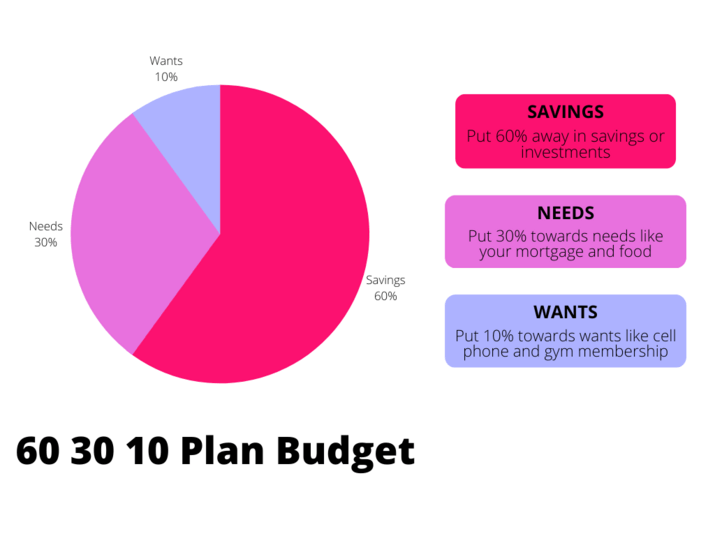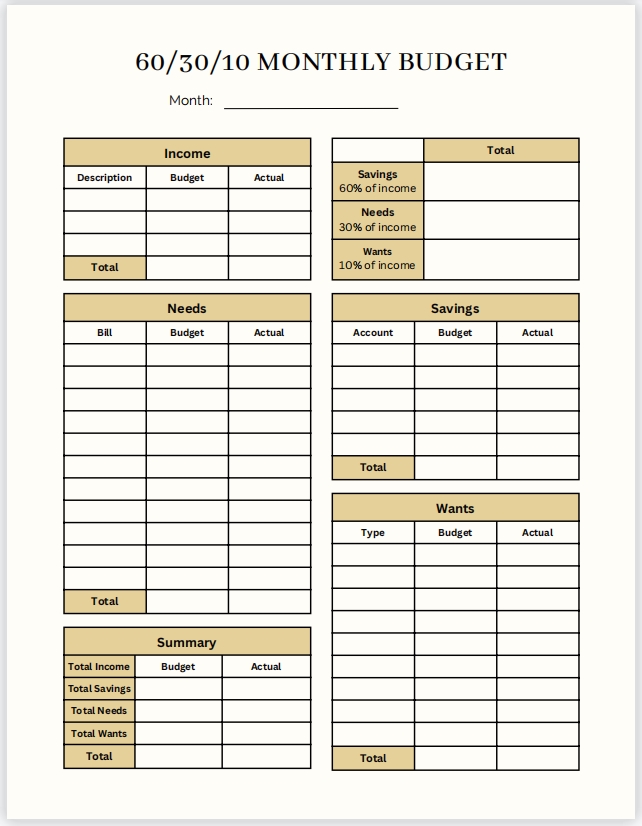The 60-30-10 Rule Budget? How it’ll Make You Rich in 2023!
When it comes to budgeting, there are a lot of different philosophies and strategies floating around out there. One you may have not heard of – and one that will have you reaching your financial goals quickly – is the 60-30-10 rule budget.
Table of Contents
ToggleIn this post, we’ll explore what this type of budget method is, how it works, and whether or not it could be a good fit for you. Ready to learn more? Let’s dive in!
What is the 60-30-10 Rule Budget?
The 60-30-10 budget rule is a type of budget that separates your expenses into three categories. According to the rule, 60% will go toward savings, such as retirement savings and an emergency fund. Next, 30% will go toward needs, such as mortgage, utilities, and groceries. Lastly, 30% will go toward wants like a car, cell phone, and other entertainment.

The 60-30-10 rule is a guideline for budgeting the percentage of your income that should go towards different expenses. Unlike other budgets that provide a greater percentage towards the essential bills, this budgeting method puts saving money above all else.
Not for the faint of heart
While the 60-30-10 rule is a great budgeting method for those who want financial freedom, it’s important to remember that most people will struggle with this budgeting system. You will either need to make a large excess in income or be living well below your means.
Not liking how the 60 30 10 rule sounds? Check out a more traditional budget plan!
If you are struggling try a different budget plan
If you are currently living paycheck to paycheck then you may want to look into another budgeting method like zero-based budgeting. This type of budget can help improve your spending habits if you are struggling financially.
Before you spend one more single dollar, improve your finances first. You can start today by reviewing your spending habits, reducing credit card debt, and starting an emergency savings account.
The 60 30 10 rule budget breakdown
Savings – 60% of your income to saving and investing
Needs – 30% of your income towards bills, groceries, etc.
Wants – 10% of your income to wants like cell phone, gym membership, or other discretionary spending.
Why budget by percentage?
When it comes to budgeting methods, using percentages isn’t the only budgeting rule you can use, though it may be the simplest. When using percentages you can just plug in numbers and go.
With zero-based budgeting, you have to go through every part of the budget until each dollar has a place. This can be time-consuming and also deter you from starting and managing your budget plan.
The amount of time it takes to budget is one of the biggest deterrents for most people. That’s what makes percentage base budgets so appealing. If the 60 30 10 budgeting rule doesn’t work for you check out the 30 30 30 10 budgeting strategy. This is a more user-friendly budgeting style for the average person.
Spend 60% of your Budget on Savings

If you’re like most people, the thought of saving 60% of your income probably sounds about as appealing as getting a root canal. But according to some experts, that’s exactly what you should be doing if you want to retire early.
Of course, for low earners or high spenders, this may seem like an impossible feat. However, if you want to make this budget work, you are going to have to make some heavy cuts in spending.
A few examples of things that would go into the savings category
- Retirement accounts
- Investing accounts
- College savings plan
- Save money for a down payment on a house
- Real estate investments
- Emergency Fund
Spend 30% of your Budget on Needs

A few examples of things that would go in the needs category
- Mortgage
- Monthly housing costs
- Utility Bills
- Insurance
- Groceries
- Debt Repayment
- Health Care
- Child Support
- Other necessary expenses
Spend 10% of your Budget on Wants

The last section of the 60 30 10 rule budget is the wants category. This category covers all your expenses not covered under the previous two categories. Only lower-income earners or the big spenders should have trouble with this budget category,
A few examples of things that would go in the wants category
- Cell phone
- Cable
- Internet
- Travel
- Dining Out
- Streaming Services
- Memberships
- Non-essential expenses
How to set up a 60 30 10 rule budget?
Let’s take a quick look at how you set up this budget.
Net Income First
Break it up into three categories
Once you know how much income you have it’s as simple as just multiplying your take-home pay by 0.6 for the savings category, 0.3 for the needs category, and 0.1 for the wants category.
Let's look at an example.
If your after-tax income is $5,000 we would split it into:
$5,000 x 0.6 = $3,000 going into savings each month
$5,000 x 0.3 = $1,500 going towards needs each month
$5,000 x 0.1 = $500 going towards wants each month
What next?
Now that you have looked at how much this budget allows for each category, compare it to how much you are currently spending. In some categories, you may have plenty, but in others, you may have some major cuts you need to make.
The biggest issue for most people when it comes to this budget is going to be in the needs category. You are going to need to find a way to reduce costs so that you can meet the 30% goal. If you have included some debt in your needs category, there is still hope for you.
Pay off debt fast

You will need to pay down the debt fast so that you can get back within the spending goals of the budget. Once you have an emergency fund set up, you will want to transition all extra money into paying off debt. Once the debt is finally paid off, you will have more money for the needs category.
Increase income
Is the 60 30 10 rule budget practical?
Is this budget method practical? The answer to this is it depends. You are going to have to look at your take-home pay and your expenses and be real with yourself. This is a budget geared towards building wealth, and not a budget method for people with a low income looking to pay off debt.
If you are struggling to cover basic needs then the 60 30 10 rule budget is not going to be for you. There are lots of budgeting techniques out there that may be a better fit for you. Don’t be disheartened, the fact that you are here means you are making the first step in the right direction.
Please check out my blog for great money-saving and budgeting techniques!
If your current income is enough to easily cover your needs each month, then the 60 30 10 rule budget is perfect for you. It’s a great way to take that additional income and turn it into substantial wealth.
Conclusion
FAQ

What are the different categories of the 60 30 10 rule budget?
The three categories in the 60 30 10 rule budget include 60% into savings, 30% into needs, and 10% into wants.
How do I know how much money to save in each category of the 60 30 10 budget?
To calculate each category simply multiply your net income by 0.6, 0.3, and 0.1 to get the total for each category.
What should I do if I overspend in one category of my 60 30 10 rule budget?
Because the save category is so large, it is not unheard of to “steal” some of your budgeting capacity from the save category and move it to the needs category.
What are some expert tips for following the 60 30 10 rule budget?
The number one tip for the 60 30 10 rule budget is to cut expenses as much as possible. The only way to save 60% of your income is by making a significant salary, or by being a “super saver.”









